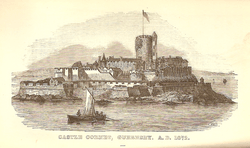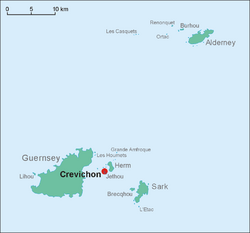Crevichon facts for kids
Crevichon is an islet off Herm, immediately to the north of Jethou, in the Channel Islands.
According to Dr S.K. Kellett-Smith, the name "Crevichon" means "island of crabs, crayfish or cranes".
Like many names in the Channel Islands, it is Norman language in origin. A thousand years ago, the water level was ten feet lower (3 m), so there were many more of the animals the island was named after.
Geography
The island is about 212 by 168 metres (696 by 551 ft) at its widest. Its area is less than 3 hectares (7.4 acres). The distance to Jethou is about 215 metres (705 ft).
History

A 16th-century drawing of the islet, now in the British Museum, shows Crevichon as apparently a wooded islet.
Prof. John Le Patourel, in The Building of Castle Cornet said that in 1566, iron and hammers were taken to "Creavissham", and the island quarried for the castle. The quarry has been used since then, but this has made the island much smaller, and less visible. As a result, a fifteen-foot (4.6 m) marker was built on the top. Crevichon may have provided the granite for the steps of St. Paul's Cathedral in London.
It is said that in earlier times, pirates were hanged on it with chains, like nearby Jethou.
Compton Mackenzie, former owner of Herm called Crevichon "Merg" in his book, Fairy Gold, which is a fictionalised version of the islands.
Wrecks
In 1953, Victor Coysh says that he saw the remains of a German bomber, from the time of the occupation.
Other wrecks include:
- Courier, a Guernsey steamer, beached in 1905 with 80 passengers.
- Channel Islets - Victor Coysh


